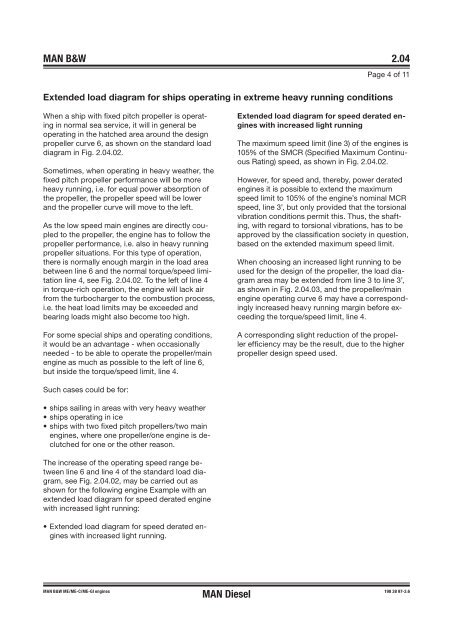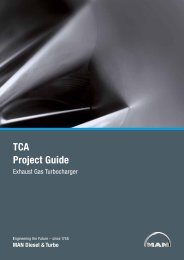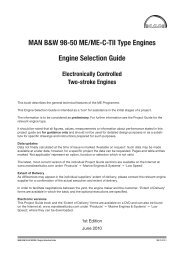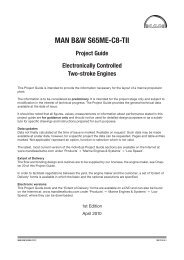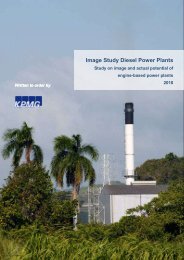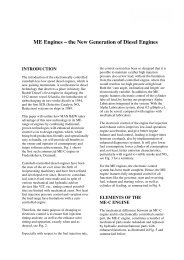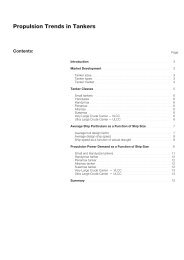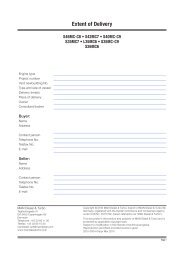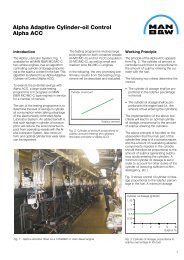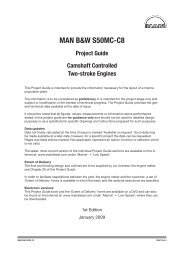This section is available on request - MAN Diesel & Turbo
This section is available on request - MAN Diesel & Turbo
This section is available on request - MAN Diesel & Turbo
Create successful ePaper yourself
Turn your PDF publications into a flip-book with our unique Google optimized e-Paper software.
<strong>MAN</strong> B&W 2.04<br />
Page 4 of<br />
Extended load diagram for ships operating in extreme heavy running c<strong>on</strong>diti<strong>on</strong>s<br />
When a ship with fixed pitch propeller <str<strong>on</strong>g>is</str<strong>on</strong>g> operating<br />
in normal sea service, it will in general be<br />
operating in the hatched area around the design<br />
propeller curve 6, as shown <strong>on</strong> the standard load<br />
diagram in Fig. 2.04.02.<br />
Sometimes, when operating in heavy weather, the<br />
fixed pitch propeller performance will be more<br />
heavy running, i.e. for equal power absorpti<strong>on</strong> of<br />
the propeller, the propeller speed will be lower<br />
and the propeller curve will move to the left.<br />
As the low speed main engines are directly coupled<br />
to the propeller, the engine has to follow the<br />
propeller performance, i.e. also in heavy running<br />
propeller situati<strong>on</strong>s. For th<str<strong>on</strong>g>is</str<strong>on</strong>g> type of operati<strong>on</strong>,<br />
there <str<strong>on</strong>g>is</str<strong>on</strong>g> normally enough margin in the load area<br />
between line 6 and the normal torque/speed limitati<strong>on</strong><br />
line 4, see Fig. 2.04.02. To the left of line 4<br />
in torque�rich operati<strong>on</strong>, the engine will lack air<br />
from the turbocharger to the combusti<strong>on</strong> process,<br />
i.e. the heat load limits may be exceeded and<br />
bearing loads might also become too high.<br />
For some special ships and operating c<strong>on</strong>diti<strong>on</strong>s,<br />
it would be an advantage � when occasi<strong>on</strong>ally<br />
needed � to be able to operate the propeller/main<br />
engine as much as possible to the left of line 6,<br />
but inside the torque/speed limit, line 4.<br />
Such cases could be for:<br />
• ships sailing in areas with very heavy weather<br />
• ships operating in ice<br />
• ships with two fixed pitch propellers/two main<br />
engines, where <strong>on</strong>e propeller/<strong>on</strong>e engine <str<strong>on</strong>g>is</str<strong>on</strong>g> declutched<br />
for <strong>on</strong>e or the other reas<strong>on</strong>.<br />
The increase of the operating speed range between<br />
line 6 and line 4 of the standard load diagram,<br />
see Fig. 2.04.02, may be carried out as<br />
shown for the following engine Example with an<br />
extended load diagram for speed derated engine<br />
with increased light running:<br />
• Extended load diagram for speed derated engines<br />
with increased light running.<br />
Extended load diagram for speed derated engines<br />
with increased light running<br />
The maximum speed limit (line 3) of the engines <str<strong>on</strong>g>is</str<strong>on</strong>g><br />
05% of the SMCR (Specified Maximum C<strong>on</strong>tinuous<br />
Rating) speed, as shown in Fig. 2.04.02.<br />
However, for speed and, thereby, power derated<br />
engines it <str<strong>on</strong>g>is</str<strong>on</strong>g> possible to extend the maximum<br />
speed limit to 05% of the engine’s nominal MCR<br />
speed, line 3’, but <strong>on</strong>ly provided that the torsi<strong>on</strong>al<br />
vibrati<strong>on</strong> c<strong>on</strong>diti<strong>on</strong>s permit th<str<strong>on</strong>g>is</str<strong>on</strong>g>. Thus, the shafting,<br />
with regard to torsi<strong>on</strong>al vibrati<strong>on</strong>s, has to be<br />
approved by the classificati<strong>on</strong> society in questi<strong>on</strong>,<br />
based <strong>on</strong> the extended maximum speed limit.<br />
When choosing an increased light running to be<br />
used for the design of the propeller, the load diagram<br />
area may be extended from line 3 to line 3’,<br />
as shown in Fig. 2.04.03, and the propeller/main<br />
engine operating curve 6 may have a corresp<strong>on</strong>dingly<br />
increased heavy running margin before exceeding<br />
the torque/speed limit, line 4.<br />
A corresp<strong>on</strong>ding slight reducti<strong>on</strong> of the propeller<br />
efficiency may be the result, due to the higher<br />
propeller design speed used.<br />
<strong>MAN</strong> B&W ME/ME-C/ME-GI engines 198 38 97-3.6<br />
<strong>MAN</strong> <strong>Diesel</strong>


